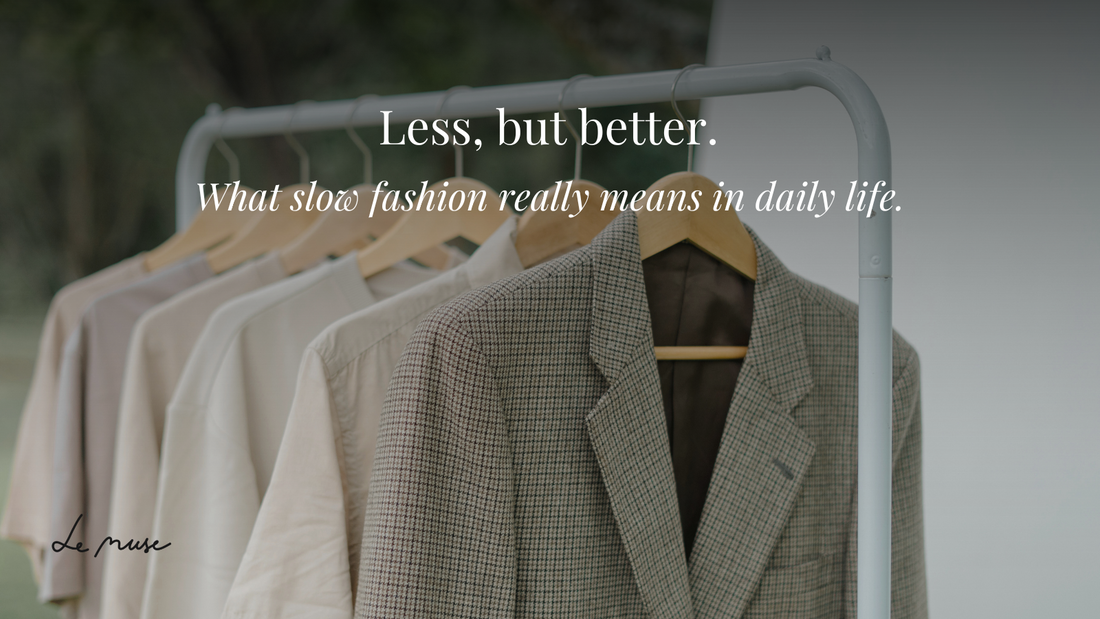
Slow Fashion, Simplified: What It Looks Like in Daily Life
We hear it all the time: slow fashion, conscious consumption, buy less, choose well. But what does that actually mean in the flow of everyday life? Is it about never buying anything new? Only wearing beige linen? Or spending hours researching brands before every purchase?
The truth is, slow fashion isn’t a strict set of rules - it’s a mindset. It’s about being thoughtful with what we bring into our wardrobes, how we wear it, and how long we keep it. It’s a quiet rebellion against trends that fade in weeks and closets that overflow but never satisfy.
At LeMuse, we live this philosophy daily. And in this article, we’re breaking down simple, tangible ways slow fashion shows up in real life: in how we choose, wear, and care for what we love.
Buy Less, But Better
Slow fashion starts with one simple shift: choosing quality over quantity.
That doesn’t mean every piece needs to be expensive or perfect. It means taking a moment to ask “Will I really wear this?” before adding it to your wardrobe. It means buying with intention, not impulse.
Here’s what “better” often looks like:
- Natural, breathable fabrics like linen or cotton that age well and feel good.
- Neutral tones or timeless silhouettes that work season after season.
- Garments that fit your life, not just your Pinterest board.
It also means building trust in the brands you support. At LeMuse, we create small-batch pieces made to be worn again and again - not tossed after a season. We believe that fewer, well-loved garments are worth far more than a closet full of “maybes.”
Tip: Next time you feel tempted to buy something new, try this: wait 48 hours. If you’re still thinking about it - and can imagine at least 3 outfits you’d wear it with - it might be worth adding to your wardrobe.

Wear what you already own
Slow fashion isn’t just about what you buy - it’s about what you keep wearing.
Chances are, your wardrobe already holds more value than you think. That dress you always feel great in? The linen shirt you wear on repeat? These are your real essentials.
Rewearing is not only sustainable -it’s powerful. It redefines what fashion means: not constant newness, but consistency, confidence, and personal style.
Here’s how to make the most of what you have:
- Rediscover your favorites. Sometimes, all it takes is new styling: a different belt, a layered knit, or a new pair of shoes.
- Rotate by season. Bring items out of storage with fresh eyes when the weather changes.
- Care well. The better you treat your clothes, the longer they’ll last and the more beautiful they become with time.
At LeMuse, we design with longevity in mind: silhouettes that hold their shape, fabrics that soften rather than wear out, and styles you’ll reach for not just once, but often.
Tip: Try a “10x10 challenge” pick 10 items from your closet and style them into 10 outfits. You might be surprised how much versatility you already own.
Care Is Part of the Culture
Slow fashion isn’t just about buying better - it’s about caring better, too.
How you treat your clothes matters just as much as where they come from.
Washing less often, airing between wears, steaming instead of ironing - these everyday habits help garments last longer, stay fresh, and reduce environmental impact. It’s a quiet, ongoing form of respect - for the item, the maker, and the planet.
This mindset also extends the life of your wardrobe. Because sustainable fashion doesn’t end at checkout - it truly begins the moment you bring that piece home.
Tip: Treat your favorite dress the way you’d treat something handmade - with care, with attention, and with the intention of wearing it for years.
Mindful Shopping: Questions to Ask
Slow fashion starts long before the checkout. It begins with thoughtful choices - pausing to ask why you’re buying something, not just what.
Next time you feel the urge to shop, consider these questions:
- Does it go with at least 3 things I already own?
Versatility is key. If you can style it multiple ways, it’s more likely to become a favorite - not a forgotten impulse buy.
- Is the fabric natural and breathable?
Linen, cotton, and wool last longer and feel better on the skin. They also break down more easily at the end of their life, unlike synthetics.
- Is the brand transparent?
Look for brands that openly share their materials, values, and production practices. (At LeMuse, we handmade each piece in small batches in Lithuania.)
- Do I want this… or just want something new?
Sometimes we shop out of habit, not need. Wait a day. If it still excites you tomorrow, it’s probably worth it.
Buying less doesn’t mean enjoying fashion less - it means choosing better and wearing what you love, more often.
Final thoughts
Slow fashion isn’t about having the perfect wardrobe - it’s about making thoughtful choices.
From picking natural fabrics to caring for what you own, it’s a quiet commitment to wear less, but better.
It’s asking: Will I wear this often? Will it last?
At LeMuse, we believe in timeless pieces you’ll reach for again and again - not just because they look good, but because they feel right.
🧵 Explore pieces made for lasting wear → dresslemuse.com
